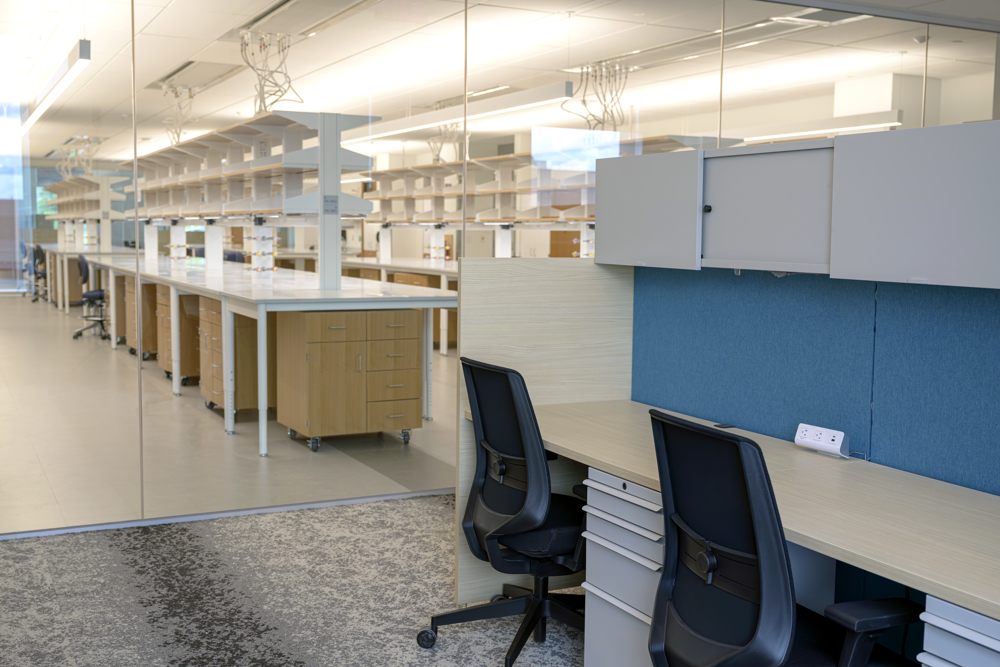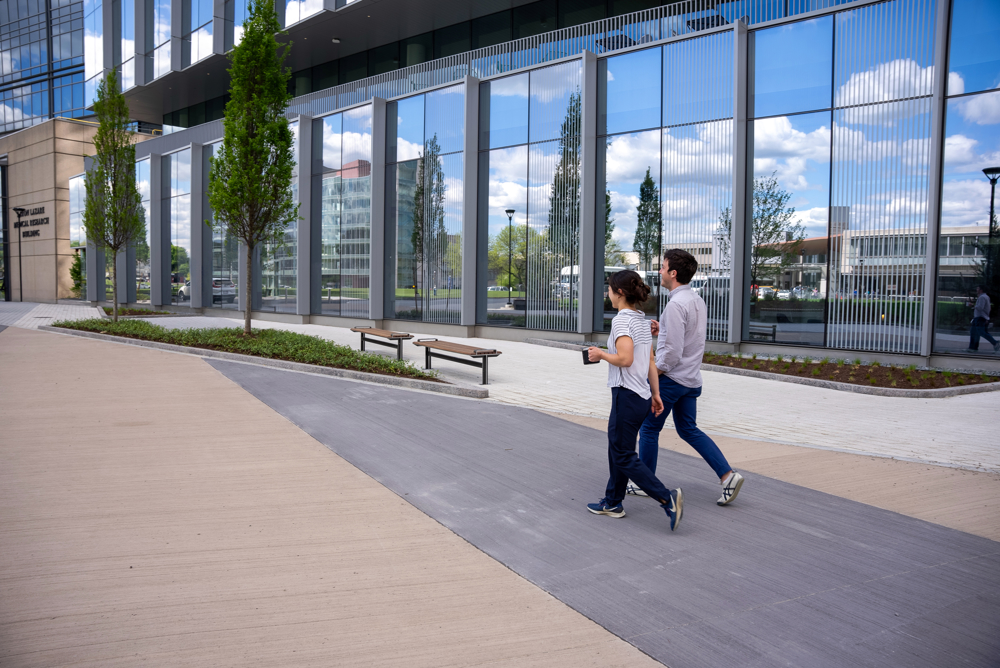Collaboration by design
By Susan E.W. Spencer

What do you get when you bring together a group of researchers and clinicians with disparate interests and disciplines? If the history of UMass Chan Medical School is any indication, you get great science.
For more than 30 years, the Medical School has traced its most notable successes to interdisciplinary collaboration. Beginning with the establishment of the Program in Molecular Medicine in 1989, the leaders of the institution planned co-location of varied investigators, knowing it could lead to groundbreaking discoveries. With the completion of the new education and research building, that approach will once again be strategically applied to conquering some of the world’s most challenging diseases.
“This building plays a key role in the future of our institution, as outlined in our strategic plan,” said Chancellor Michael F. Collins. “By co-locating strategic research programs and leveraging the power of collaboration, we will be able to fulfill our vision of life-changing therapies for some of the most intractable diseases we face.”
The model of neighboring research communities in the new 350,000-square-foot building will bring together under one roof the UMass Chan Program in Molecular Medicine, departments of neurology, neurological surgery, neurobiology, psychiatry, the Senator Paul D. Wellstone Muscular Dystrophy Cooperative Research Center and the Horae Gene Therapy Center.
The building represents a continuation of an institutional vision articulated in 1990 “to spark a research growth spurt across the entire campus, as measured by recruitment, external funding, scientific discoveries, and honors and awards,” that led to the establishment of the Program in Molecular Medicine, as Ellen S. More, PhD, professor emeritus of psychiatry, wrote in The University of Massachusetts Medical School, a History: Integrating Primary Care and Biomedical Research.
The Program in Molecular Medicine is “a different kind of department,” said Roger J. Davis, PhD, FRS, the H. Arthur Smith Chair in Cancer Research and chair and professor of molecular medicine. “We have people in the department in basic research and people who are involved in clinical trials. It makes for the ability to do very rapid transfer of new research findings into clinical relevance. Basic scientists can deal with people who are doing clinical trials and get their advice for advancing their research, and clinicians can get insights from basic scientists.”
Such collaboration has already led to progress in conditions like Alzheimer’s disease, fragile X syndrome and diabetes, and on pathogens such as SARS-CoV-2 and Ebola, according to Dr. Davis.
“These buildings are real opportunities. They help us to recruit new faculty and provide new space that we can develop for paradigm-changing technologies.”
“We’ll be right in the heart of the campus, and I think it’s going to amplify our ability to collaborate with others,” Davis said.
Terence R. Flotte, MD, the Celia and Isaac Haidak Professor, executive deputy chancellor, provost and dean of the T.H. Chan School of Medicine, said the building’s focus on bringing together a network of neuroscience researchers with those exploring potential new treatment technologies was by design.
“One of our most distinctive areas of achievement and of future opportunities in gene therapy has been for neurologic diseases—both those that affect adults like ALS and those that affect children like Canavan and Tay-Sachs disease,” said Dr. Flotte. “Many of the gene therapy platforms that we put forward as neurologic therapies have also facilitated a deeper understanding of the nervous system. So, we have assigned the Department of Neurobiology to the new building. We are co-locating them with neurology and gene therapy, which enables the creation of a sense of community among investigators.”
An exciting new metabolomics facility will also be housed in the building, with potentially far-reaching impacts on finding treatments for conditions from heart disease to diabetes, cancers and rare diseases, Flotte said. With support from the Stoddard Charitable Trust, UMass Chan investigators will have access to multimodal mass spectroscopy and other integrated equipment to profile small molecule metabolites in cells and better understand predictive biomarkers and pathways underlying diseases.

“These buildings are real opportunities,” said Flotte. “They help us to recruit new faculty and provide new space that we can develop for paradigm-changing technologies.”
UMass Chan is already a leader in gene therapy research, said Guangping Gao, PhD, the director of the Horae Gene Therapy Center and the Li Weibo Institute for Rare Diseases Research, who is looking forward to the move. Currently, faculty members of the gene therapy center are spread across several buildings.
“This move into the new building, putting all the gene therapy center members under one roof, is going to make a huge difference,” said Dr. Gao, the Penelope Booth Rockwell Professor in Biomedical Research and professor of microbiology. “It not only promotes our highly collaborative research environments, but it’s also very important to enhance research efficiency with all equipment and everything in one place.”
The gene therapy center’s research, which could provide insights into thousands of diseases, has several treatments in the pipeline, Gao said. The bigger space will increase opportunities for collaboration among investigators and graduate student trainees.
Gao has seen gene therapy research grow during his 15 years at UMass Chan, and now, he said, “The state-of-the-art facility will facilitate our research capability and the speed to move from proof of concept to clinical translation. It will also facilitate our dream to develop therapies to treat the patients and change quality of life for them and their families. That’s what we’re really looking forward to.”
Some of UMass Chan’s recent leading advances such as a promising gene therapy for Tay-Sachs disease are equally attributable to close collaboration with neurosurgeons who perfect complex techniques for delivering the therapy to the brain and other intricate procedures, often in very young children.

“This state-of-the art facility is a testament to the incredible commitment that UMass Chan has made to the study of the nervous system, the treatment of its disorders and the power of ‘team science’,” said Mark Johnson, MD, PhD, the Maroun Semaan Chair in Neurosurgery and chair and professor of neurosurgery. “For the first time at our institution, principal investigators in the Department of Neurological Surgery will be able to work side by side, sharing resources, exchanging ideas and collaborating on a daily basis. We fully expect that our inclusion in this community of world-class scientists will foster collaborations that will enhance our research and yield new and transformative discoveries in our field."
“This move into the new building, putting all the gene therapy center members under one roof, is going to make a huge difference.
It not only promotes our highly collaborative research environments, but it’s also very important to enhance research efficiency with all equipment and everything in one place.”
While gene therapy is a major focus for treatment research at UMass Chan, collaboration between the departments of neurology and neurobiology has also led to advances in multiple neurodegenerative diseases, according to Daryl A. Bosco, PhD, professor of neurology.
“We have projects together on microglia and neuroinflammation, which is a major pathogenic process, and now that has culminated in a publication that was just accepted,” Dr. Bosco said. “So, it’s really exciting to be able to have proximity to their labs and other people in neurobiology.”
Bosco and A.M. Barrett, MD, chair and professor of neurology, agreed that the open layout, with areas where people working in the lab can see each other and write-up stations are interspersed with offices outside the lab, will increase morale and a sense of community among researchers and trainees.
“I would say that the power of this environment, which is very intentional, is one that is going to help people to optimize their productivity,” Dr. Barrett said. “And I think it’s going to help the emotional aspect of our culture to have access to this kind of a building.”
What’s more, Barrett and Bosco said, the Medical School’s investment in neuroscience and basic and translational research helps recruit top new researchers, including those working in critical areas like Alzheimer’s disease.

One of the new researchers attracted by UMass Chan’s model of cross-discipline collaboration is Danny G. Winder, PhD, the Worcester Foundation for Biomedical Research Chair I and chair and professor of neurobiology. Dr. Winder is a renowned expert in the field of addiction neuroscience, founding director of the Vanderbilt [University] Center for Addiction Research and principal investigator on the multi-institutional Vanderbilt AUD Research and Education Center (VAREC), a National Institutes of Health effort to develop innovative approaches to solving alcohol use disorders, in which UMass Chan participates.
“The neurobiology department is focused on gaining a basic understanding of the building blocks of the nervous system and understanding how it works both in normal and abnormal situations,” Winder said.
The department’s rich history of working with multiple model systems allows rapid progress to be made and new biology to be uncovered quickly, he said, adding that proximity in the new building to the neurology, psychiatry and neurosurgery departments and clinical insights from their investigators will reduce barriers for moving those discoveries toward potential therapeutics.
“My own work focuses heavily on alcohol use disorder, and we are really excited about the new building because it’s well designed to allow us to do the sorts of experiments that we plan to undertake with the new VAREC grant,” Winder said.
The experimental suites in the building will facilitate researchers’ ability to do high-end neuroscience to explore neural circuits in animal models. For example, the department has ordered miniature microscopes that can monitor the fluorescence signals coming from specific populations of neurons.

“We can monitor the activity of those specific cells and see them in real time. So, it’s really game-changing technology in the field of neuroscience that we’re excited to be able to take advantage of,” said Winder.
Winder’s department also collaborates with the Department of Psychiatry on areas of common interest, including sleep disorders and how alcohol controls behavior in the brain.
“This is a wonderful opportunity for our researchers,” said Kimberly A. Yonkers, MD, the Katz Family Chair in Psychiatry and chair and professor of psychiatry. “The facility is state of the art, and it will allow researchers who may be in different departments but are doing neuroscience research to be close to one another.”
How will UMass Chan leaders know whether the promise of the new building is fulfilled?
“I think the most important measure is to see our faculty doing impactful research. Some of those researchers will be working on model organisms and some will have a translational focus,” said Flotte. “It all supports our public service mission: Let’s see the work that creates new paradigms that change the course of disease.” ■